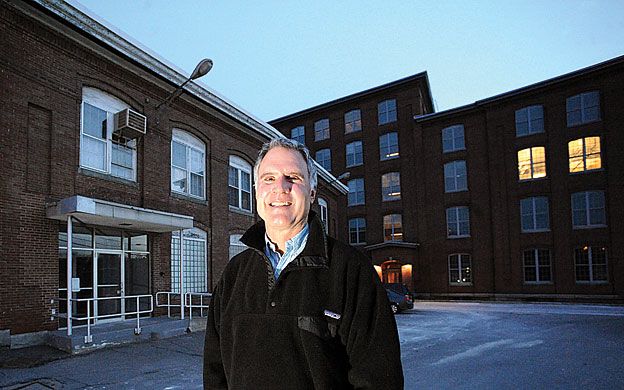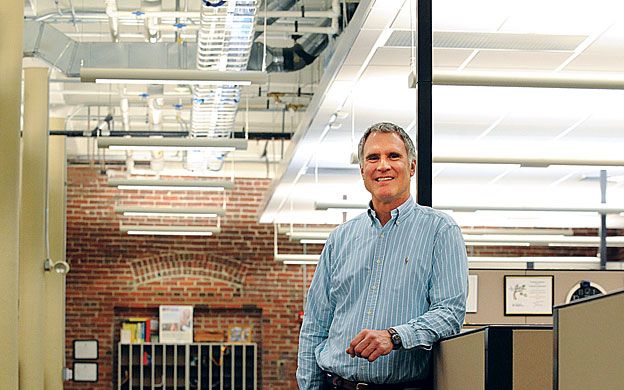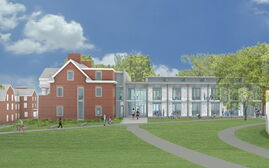Boghossian tees up Lockwood Mills development
When Paul Boghossian launched the partnership that restored the historic Hathaway Mill in Waterville five years ago, he had no idea he'd just now start renovations to the other two buildings in the mammoth Lockwood Mills complex.
Back in 2007, there had been no Wall Street collapse, nor tighter lending standards that were adopted in its wake. He also had a North Carolina business partner who had been hailed as a master of mill restorations and headed up his own capital investment firm.
Almost simultaneously, development money vanished, as did his business partner, leaving Boghossian as the sole developer to finish restoration of the former Hathaway Shirt factory. Today, the complex houses 67 apartments and 130,000 square feet of office and retail space and Boghossian is ready to turn his full attention to the Lockwood Mills complex.
At just shy of 500,000 square feet, it's one of the largest remaining 19th century industrial sites in Maine, and is immediately adjacent to Waterville's downtown. The Main Street shopping district lies just across a six-lane approach road to the bridge to Winslow.
Reconfiguring traffic so that Waterville has a pedestrian-friendly downtown is just one of the issues Boghossian is tackling in his most recent project, which includes refurbishing two buildings previously occupied by Central Maine Power Co. and Marden's, and putting him before the planning board and city council, so far to generally favorable receptions.
He envisions a hotel, restaurants, retail and office space, and many new apartments — one of the most successful features of the Hathaway renovation.
"When I was trying to show an apartment there recently, I had to show my own unit," he says. "None of the others were vacant."
Boghossian, a Colby College grad who began his career restoring mills in his native Rhode Island, also wants the city to commit to $1 million in road and intersection improvements that include restoring two-way traffic to Main Street and replacing the six-lane arterial — which he calls "hopelessly inefficient" — with a roundabout similar to the one that originally marked the site.
Waterville Mayor Karen Heck says the traffic plan is doable, and necessary to recreate the downtown ambience that once brought shoppers from around the region.
"Paul has invested years of his life and millions of dollars in our city," Heck says. "It's about time we reciprocated."
A partnership gone sour
Boghossian says redeveloping the two buildings, collectively about the same size as the Hathaway Creative Center that he renovated and re-opened in 2008, will cost $20 million-$25 million. The overhaul of the National Historic Register properties will use both federal and state historic tax credits.
"That's what makes projects like this viable," he says. "It's like having 55-cent dollars when you go to the bank."
He's learned some valuable lessons in financing, he says, following the almost four years it took to extricate himself from an original partnership with Tom Niemann, a North Carolina developer who owns the Kennebec Arsenal in Augusta. That long-stalled project has resulted in the state exploring litigation to reclaim the property.
Problems, Boghossian says, began almost immediately after the finishing touches were put on the Hathaway project in the winter of 2008-09. Niemann was supposed to manage the two largely vacant Marden's and CMP buildings and bring in financing to replace the $500,000 Boghossian had invested in them, supposedly for the short-term only.
"He never brought in a dime," Boghossian says of Niemann. "And he didn't even pay the electric bill or fill the oil tanks. The tenants were repeatedly given shutoff notices."
Attempts by Mainebiz to reach Niemann for comment were unsuccessful.
Boghossian started foreclosure proceedings that dragged on for years. They ultimately resulted in default judgments in September, making him sole owner of the Marden's and CMP buildings. Niemann remains the largest single owner of the Hathaway building, though with a minority share.
Boghossian concedes some of the delays would have happened anyway, even without the wrinkle of the failed partnership.
"There was no financing for this kind of project after the financial crash, and it isn't likely that we'd have been able to sign up anchor tenants," he says. Now that the economic forecast has brightened a bit, he thinks it's time to go forward with the Lockwood project.
The middle CMP building, at 53,000 square feet and two stories, and the Marden's building that overlooks downtown — four-and-a-half stories and 168,000 square feet — lend themselves more to housing than commercial development, more so even than the Hathaway project, says Boghossian. He contrasts Hathaway's fully occupied apartments with about 80% occupancy rate of its office space and a lower proportion of the first-floor retail.
"These two buildings are narrower, and we'll be able to get away from the longer, deeper spaces that make the Hathaway units relatively large for downtown living," he says.
Many of the Hathaway apartments are 1,000 square feet or larger, and carry market-based rents of $1,000 a month. The units offered in the other buildings will run from 500-800 square feet, and average 650 square feet, which will make rents about $750.
"In this market, that's much more affordable and increases their appeal," he says.
The Marden's building has drawn considerable interest from hoteliers, says Boghossian, and could support an 80-room inn with a large restaurant, along with retail units and some housing.
"That's one of the things downtown needs to put it back on the map," he says. Existing hotels and motels are all clustered around Waterville's two interstate exits, the closest well over a mile away.
Boghossian is thinking even further down the road, to a possible cooperative program with Thomas College, which offers a popular program in hotel management. "They're always looking for places to intern, while hotel chains are also looking for good employees," he says. "It could be an excellent match."
If a hotel does locate in the mill buildings, a parking structure across the street on a city-owned lot would be needed. Boghossian envisions a series of walkways connecting the three buildings and the garage, so that — as in other northern cities — tenants could access the entire complex, and reach their cars, without ever having to step outside.
Municipal interests
During the long foreclosure process, Boghossian found other roles to play in Waterville. Mayor Heck appointed him to a city committee to see if the Robert LaFleur Airport could pay benefits to the city.
When Paul LePage was mayor, Heck says, he had essentially mothballed the airport after terminating an agreement with the operator, Telford Aviation. LePage proposed selling the property, but the city council took no action.
With representation from area pilots and the Mid-Maine Growth Council, the committee discovered that the airport could be a real asset, Boghossian says. It created a website for the airport and discovered it had an unused foreign trade zone on land next to I-95. Since then, the city has bought a 62-acre parcel next to the airport and zoned it for light manufacturing.
Heck reports that, thanks to the committee's efforts, the airport, which lost $139,000 in 2011, came within $5,000 of breaking even in 2012 and expects to turn a profit for the city in 2013.
"On one summer weekend, Tony Blair and Bob Diamond [the former British prime minister and ex-Barclay's Bank chair] flew in and we sold $26,000 in jet fuel," Heck says. "How could we not take advantage of those opportunities?"
When he looks at Waterville, Boghossian agrees with city development plans that see four growth areas: medical (with MaineGeneral and Inland Hospital); education (Colby, Thomas); retail; and manufacturing. To these he adds a fifth — arts and entertainment. The Maine International Film Festival, the premier event of its kind in the state, and its offshoot, the Maine Film Center, put Waterville on the map in a new way, he says.
He'd like to see artists living downtown, along with nurses and teachers in the new Lockwood units, and recognizes that a growing residential cluster means more traffic changes. The city did a study in 2009 intended to improve pedestrian access to Hathaway, but no concrete measures were taken to implement that plan, Boghossian says. Now, he thinks the city must take a wider look, and take on vehicular traffic, too.
The study would cost $80,000, but Heck says it's something the city needs to do.
Boghossian says that new traffic patterns wouldn't banish vehicles from downtown, but they would restore a balance lost when Main Street became a throughway. For one-way streets, buildings on the near sides of intersections are almost invisible to drivers because they're looking for entering traffic from side streets, says Boghossian.
"There's a great tea shop that many people don't know is there because it's on the wrong corner," he says.
Inspirations from the past
When he's having a difficult moment, as Boghossian says he does now and then, he takes inspiration from the original story of the Lockwood Mills. When a group of wealthy Waterville citizens decided the time was ripe for a major industrial expansion in the 1870s, they chose Amos D. Lockwood, who'd built mills in Boston and Providence, R.I., as their designer and engineer.
Not only was Lockwood a skilled building designer, Boghossian says, he was "a practical genius" when it came to waterpower, and in charting the intricate channels of penstocks, sluiceways and millwheels that went into making an efficient 19th century plant. By 1876, 33,000 textile spindles were in operation and the Lockwood Co. employed 1,300 people at its peak, with production continuing until 1955. Hathaway Shirt then took over, renovated the largest building and continued production until 2002.
"The owners were so impressed that they named their company not after themselves, but their builder," Boghossian says. In bringing these mill buildings back to life, he says he hopes to replicate a similar brand of persistence and ingenuity.
Douglas Rooks, a writer based in West Gardiner, can be reached at editorial@mainebiz.biz.
Read more
















Comments